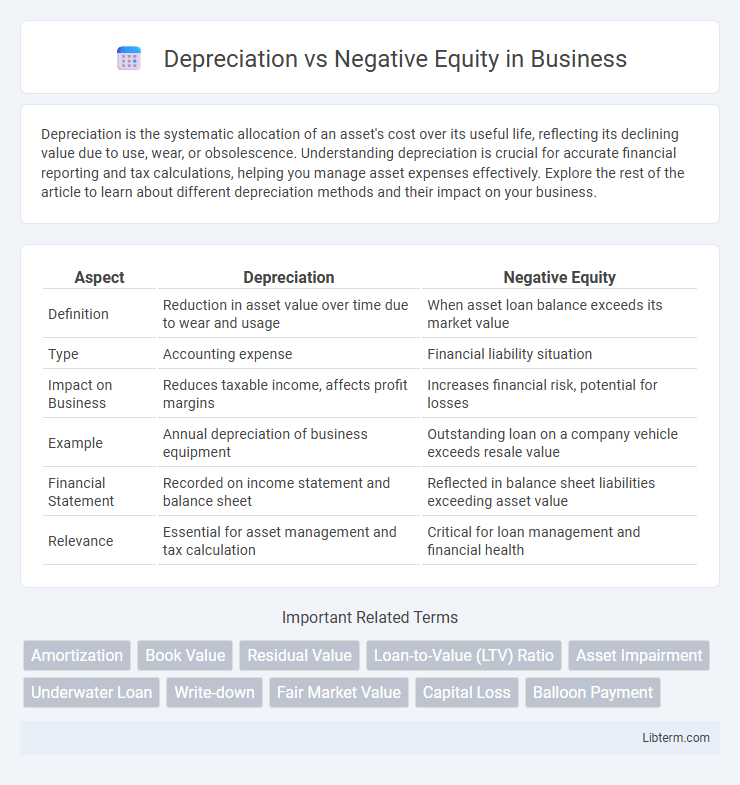Depreciation is the systematic allocation of an asset's cost over its useful life, reflecting its declining value due to use, wear, or obsolescence. Understanding depreciation is crucial for accurate financial reporting and tax calculations, helping you manage asset expenses effectively. Explore the rest of the article to learn about different depreciation methods and their impact on your business.
Table of Comparison
| Aspect | Depreciation | Negative Equity |
|---|---|---|
| Definition | Reduction in asset value over time due to wear and usage | When asset loan balance exceeds its market value |
| Type | Accounting expense | Financial liability situation |
| Impact on Business | Reduces taxable income, affects profit margins | Increases financial risk, potential for losses |
| Example | Annual depreciation of business equipment | Outstanding loan on a company vehicle exceeds resale value |
| Financial Statement | Recorded on income statement and balance sheet | Reflected in balance sheet liabilities exceeding asset value |
| Relevance | Essential for asset management and tax calculation | Critical for loan management and financial health |
Understanding Depreciation: A Brief Overview
Depreciation refers to the gradual decline in a vehicle's market value over time, influenced by factors such as age, mileage, and condition. Understanding depreciation is crucial in finance as it directly impacts negative equity, which occurs when a car's outstanding loan balance exceeds its current value. Accurate knowledge of depreciation rates helps consumers make informed decisions on loan terms and resale timing to avoid negative equity situations.
What is Negative Equity?
Negative equity occurs when the outstanding loan balance on an asset, such as a car or property, exceeds its current market value. This situation often arises due to rapid depreciation, where the asset's value declines faster than the loan is repaid. Managing negative equity is critical in financial planning to avoid potential losses or complications during asset sale or refinancing.
Key Differences Between Depreciation and Negative Equity
Depreciation refers to the reduction in the value of an asset over time due to wear and tear or market conditions, while negative equity occurs when the outstanding loan balance exceeds the current market value of that asset. Depreciation is an accounting expense influencing asset valuation, whereas negative equity is a financial state impacting loan repayment and asset ownership. Understanding these distinctions is essential for managing asset investments, especially in automotive and real estate markets.
Factors Causing Depreciation in Assets
Depreciation in assets occurs due to factors such as wear and tear from regular use, obsolescence caused by technological advancements, and market demand fluctuations reducing the asset's value. Negative equity arises when the outstanding loan balance exceeds the current market value of the asset, often amplified by rapid depreciation. Understanding the drivers behind asset depreciation helps in managing risks associated with negative equity in financing scenarios.
How Negative Equity Develops in Loans
Negative equity develops in loans when the outstanding loan balance exceeds the current market value of the asset, commonly occurring with vehicle or home financing. Rapid depreciation of the asset's value, combined with high-interest rates or minimal initial down payments, accelerates the gap between loan balance and asset worth. This situation often worsens when borrowers skip or delay payments, causing principal to remain high while the asset's value continues to decline.
Depreciation vs Negative Equity: Real-Life Examples
Depreciation significantly impacts vehicle value, often causing cars to lose 20-30% of their worth within the first year, which can lead to negative equity when the loan balance exceeds the car's current market value. For instance, a buyer who finances a $30,000 car with a 5-year auto loan might owe $25,000 after one year, but the car's market value may have dropped to $22,000, resulting in $3,000 of negative equity. Understanding this relationship helps consumers make informed decisions about loan terms and vehicle choices to minimize the risks associated with depreciation and negative equity.
Impacts on Asset Value and Financial Health
Depreciation directly reduces an asset's book value over time, reflecting wear, tear, and obsolescence, which impacts the accuracy of financial statements by lowering reported asset values. Negative equity occurs when an asset's market value falls below the outstanding loan balance, leading to potential financial strain through increased liabilities exceeding asset worth. Both depreciation and negative equity affect a company's financial health by diminishing net asset value, restricting borrowing capacity, and increasing the risk of insolvency.
Managing Depreciation and Avoiding Negative Equity
Managing depreciation involves regular vehicle maintenance and selecting models known for slower value loss to preserve equity. Avoiding negative equity requires making substantial down payments and refinancing promptly if the loan exceeds the car's market value. Monitoring market trends and adjusting loan terms can also mitigate the risk of owing more than the vehicle's worth.
Depreciation in Real Estate vs Automotive Sector
Depreciation in real estate typically occurs at a slower rate, influenced by factors such as property location, market demand, and maintenance, which often allow properties to retain or appreciate over time. In contrast, automotive depreciation is rapid and steep, with vehicles losing up to 20-30% of their value within the first year due to wear, mileage, and technological obsolescence. Understanding these distinct depreciation patterns is crucial for asset valuation, investment strategies, and managing negative equity risks in both sectors.
Frequently Asked Questions About Depreciation and Negative Equity
Depreciation refers to the decline in a vehicle's value over time, which often contributes to negative equity when the remaining loan balance exceeds the car's market value. Negative equity occurs when a borrower owes more on a loan than the asset is worth, commonly impacting auto loans, mortgages, and personal financing. Frequently asked questions address how depreciation affects resale value, strategies to avoid negative equity, and the implications for trade-ins and refinancing options.
Depreciation Infographic

 libterm.com
libterm.com